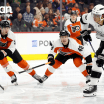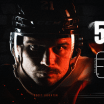The long-delayed 2020 NHL Draft is not considered to be an exceptionally deep one in terms of available "can't miss" superstar talents beyond surefile first overall pick Alexis Lafreniere. However, there are fine prospects available throughout most of the first round and odds favor a few blossoming into NHL standouts as their post-Draft development takes its course.
Flyers assistant general manager and vice president says that the identities of the top 25 prospects are likely similar from one NHL team's list to the next. However the specific order of each organization's Draft candidate rankings is almost certain to vary widely.
Meltzer's Mock Draft: 2020

"Obviously, [Lafreniere] is number one, like everybody knows. Then after that, I think there are a couple guys in the next range and then probably the next 11 or 12 this year. I think it's gonna be interesting. There's a lot of good, really good players, different positions, different styles, whether it's a scorer, D-man, centerman, skill player, goalie, whatever. there's a number of top end players then a drop off a little bit," Flahr said.
"There's a grouping from there, probably [top] 25 or so, that could go in lots of different directions. We're picking 23. I think we'll get a player that's higher up on our list is my guess, the way it usually works. It'll be interesting to see how it falls."
The following 2020 first-round mock Draft is strictly a hypothetical exercise by the author. Any resemblance between the selections within it -- including the Flyers' selection at 23rd overall -- and the actual progression of the first round is after picks come the first round are coincidental. Secondly, a straightforward "best player available" methodology was used, rather than an in-depth positional depth analysis of all 31 NHL farm systems.
1. New York Rangers: Alexis Lafreniere (LW)
The NHL Draft Lottery winning Rangers have the easiest decision of the first night of the Draft. Lafreniere is universally considered a can't-miss future first-line NHL player. He may not quite be in the class of Connor McDavid or Sidney Crosby in their Draft year but he's the next step down. Lafreniere has good speed, excellent hands, competitive drive, two-way awareness and strong hockey sense. An outstanding performance at the 2019-20 World Junior Championships further cemented Lafreniere's status as the top Draft prospect.
2. Los Angeles Kings: Quinton Byfield (C)
There is not unanimous agreement around the hockey world that Byfield is the next-best candidate for the 2020 Draft after Lafreniere. Nonetheless, it would be hard to go wrong taking the Sudbury Wolves center. He's one of the biggest and physically strongest (6-foot-4, 215 pounds) players in this year's prospect crop, yet he's also a fine skater. There's also room to further fill out his frame and play at 220-plus well-hewn pounds. He's also been dominant at the OHL level (32 goals, 82 points in 45 games). There are some scouts who question whether Byfield will excel offensively against NHL-caliber checking when he's no longer playing against physically immature players. There are some who say he "doesn't play with as much jam as you'd like for such a big player." Others, however, see a future star who is already a good passer and can score in bunches at the junior level. It's also worth noting that Byfield is one of the youngest players in the 2020 Draft. He is nearly 10 months younger than Lafreniere, for example.
3. Ottawa Senators: Tim Stützle (C)
The Senators own the third (originally belonging to the San Jose Sharks) and fifth overall picks of the Draft. Will they go for two forwards or a forward and a defenseman? If Ottawa were to bypass Stützle here, he might not make it to the fifth slot. One of three German players who could go in the first round this year -- while 2020 is not a particularly strong Draft for Europe in general, it's a bumper crop from Germany -- Stützle has superstar caliber playmaking upside, very good speed and an ability to make plays while at top speed, dazzling stickhandling and two-way upside. He is already more than holding his own in the DEL (Germany's top pro league, which features numerous veterans with high-level North American experience, including some who played in the NHL and many former AHLers), and excelled at his first World Junior Championships despite lacking eye-popping stats in the tourney.
4. Detroit Red Wings: Alexander Holtz (RW)
Do the Red Wings become the first team to select a defenseman in the draft or do they look for a potential impact forward? Given that the Red Wings historically drafted heavily -- and quite effectively -- from Sweden, the pick here is Swedish forward Holtz. Some sources prefer countryman Lucas Raymond to Holtz in terms of perceived longtime all-around upside -- the opinion of legendary scout Håkan Andersson will, of course, weigh heavily in Detroit's internal ranking -- but there are two compelling reasons to take Holtz in this spot. First and foremost, there's a little less projection involved. Holtz is one of the two or three best pure shooters in the Draft (many would rate him as No. 1) and is considered close to being NHL ready. He has already competed effectively against grown men and has been playing in order age groups for years (he's been on the 2020 NHL Draft radar since he was 15). Holtz isn't a deficient skater; just not a flashy one. There are better playmakers available. But Holtz is a safe bet to score goals in the NHL, and probably sooner than later. The current Red Wings are starved for goals, and Holtz can address some of that need in the relatively near future.
5. Ottawa Senators: Jake Sanderson (D)
I considered two defensemen (Sanderson and Jamie Drysdale) and three forwards (Raymond and Ottawa 67's forwards Marco Rossi and Jack Quinn). It was tempting to take a second dynamic forward prospect to go along with Stützle, but the selection here is University of North Dakota committed USNTDP defenseman Sanderson. The son of former NHLer Geoff Sanderson (an ex-Flyer), Sanderson is one of the fastest and smoothest skaters in this year's Draft, and a highly advanced all-around game. It's not uncommon to hear NHL top-pairing projections for his future. Sanderson makes good reads off-puck, triggers clean exits and can fly up the ice to join the rush. The offensive part of his game has really started to fall in place over the last year. At minimum, he should be a strong puck-mover who is also reliable in his own.
6. Anaheim Ducks: Jamie Drysdale (D)
Lack of size is no longer considered a hindrance for defensemen. Plenty of smallish, speedy and highly skilled blueliners have been selected in the upper half of the first round in recent years, including Cam York by the Flyers last year. A fixture on Canadian national teams in various age groups who has already played in the World Junior Championships (which is quite rare at age 17), Drysdale is an exceptional skater and thinks the game at a very high level. A very slick passer, Drysdale doesn't have an overwhelming shot but is accurate (which is more important) and a right-handed shooter to boot. As with Sanderson, there is top-pairing upside with Drysdale. He will need to get stronger physically before he cracks the NHL but the rest is there.
7. New Jersey Devils: Lucas Raymond (LW/RW)
A dynamic and well-rounded talent who rates very highly in terms of puck skills and speed and does a lot of subtle things well, Raymond was held back a bit by a bout with mono. He's off to a strong start in the 2020-21 SHL regular season, which has already started. Raymond isn't big but is elusive and agile. It's anticipated that he'll nicely fill out his 5-foot-10 frame.
8. Buffalo Sabres: Marco Rossi (C)
The OHL's Ottawa 67's boast two different Draft-eligible players with top-10 talent: Rossi and Quinn, who were not linemates at 5-on-5 this past season. Which player gets taken first? This is where a mock draft and a real-life Draft can differ. It's easy to be bold when there's no consequence if you guess wrong. It's a different matter when you have to take a genuine risk. Last year, the 5-foot-8 Cole Caufield slipped to 15th in the first round despite his clearly elite offensive upside. Even at that mid-round spot, Caulfield became the highest-ever selected player for someone that small. Austrian forward Rossi is only one inch taller than Caufield, although significantly more filled-out physically. He's a decent skater but not an elite one. What he does have in spades is elite hockey sense, a very high degree of competitiveness, phenomenal playmaking upside and a deft finishing touch. Rossi racked up 120 points in just 56 games played in 2019-20. He is a late birthdate player (born just 8 days too late to qualify for the 2019 Draft) but even draft-plus two players rarely score at more than a two-points-per-game pace in major junior hockey.
9. Minnesota Wild: Jack Quinn (RW)
Another late-birthday player (Quinn was born Sept. 19, 2001), the right winger took a big step forward in his second full OHL season. Quinn exploded for 52 goals and 89 points in 62 games in 2019-20. Vitally, he did it without sacrificing the solid off-puck play that was considered his primary strength heading into his Draft-eligible season. He's an all-situations player who plays high in the penalty killing rotation as well as being a power play regular. Has a quick shot release and is unselfish with the puck, making typically strong pass-or-shoot decisions on the attack. Quinn is an above-average skater, but not elite. He is of average size and frame; neither is a concern. While Quinn is not expected to score at a prolific rate at the NHL level, his completeness as a prospect makes him a viable top-10 candidate.
10. Winnipeg Jets: Kaiden Guhle (D)
The Prince Albert Raiders defenseman brings a combination of mobility, size (6-foot-2 plus), physicality and all-situations upside. Guhle's offensive game improved significantly this past season, and he was always sound defensively. Guhle is an above-average skater, although not quite in the same category as Drysdale or Sanderson. His frame is still not filled out, as is typical with the majority of players his age, but he has the potential to eventually play at around 200 pounds. The question mark is whether the offensive game he's shown over the past year will continue to emerge. He's a safe bet to play on an NHL penalty kill someday, and if he does become at least a PP2 type offensively, there's top 3 upside.
11. Nashville Predators: Cole Perfetti (C/W)
Many of the higher-skill forwards in this year's Draft are a bit undersized. Few have the Saginaw Spirit center's level of hockey sense and are as deadly with the puck on his stick --Perfetti is a play driver in the purest sense because he is a spectacular stickhandler, an elite playmaker and a slick finisher when one-on-one with the goalie. Perfetti's line is usually in possession of the puck when he's on the ice. As a pro, Perfetti may play on a wing rather than at center. His defensive instincts are solid but will need to be polished to compete effectively at the NHL level. He will also need to add strength and improve the explosiveness of his skating.
12. Florida Panthers: Seth Jarvis (RW)
Jarvis is one of the higher-risk, higher-reward options projected to be selected in the first round of this year's Draft. He is a dynamic, highly skilled winger with NHL PP1 potential. On the flip side, to play in the National Hockey League (where every coach demands attention to off-puck detail), he's either going to have adapt his all-around game or he's going to have to post a lot of points. However, Javis has the potential to work through defensive concerns. He can kill penalties, but so far it's more as a threat to pick off a pass and speed off on a shorthanded counterattack than as a defensive asset. He has the feet to back off defensemen, the shot (and willingness to shoot) to score goals in bunches but also the passing touch to keep defenses honest. Jarvis is small, both in height (generously listed at 5-foot-10) and frame. He likes to dangle with the puck, and it works for him well in junior hockey, but how will he fare against NHL-caliber checking? Rankings for Jarvis range from borderline top 10 to the latter one-third of the first round. Selecting Jarvis is a swing for the fences. His speed, offensive awareness and hands are good enough that's it's a reckless risk to select him but it's a gamble that he approaches his offensive ceiling because that's going to be the biggest key to his contributions.
13. Carolina Hurricanes: Yaroslav Askarov (G)
Goaltending has been a sore spot for the Hurricanes that has held the otherwise deep team back to some degree in recent years. Last year, Carolina took the second goalie off the board when they opted for Russian netminder Pyotr Kochetkov with the fifth pick of the second round (36th overall). Kochetkov is progressing well through his draft-plus-one year and early into the 2020-21 KHL regular season. However, it is very tempting both from a best available player and a positional need/depth standpoint to select another Russian netminder by taking Askarov in this slot.Kotchetkov's presence in the prospect pipeline should not be a deterrent. Askarov is a lock to be the first goalie off the board this year and is even more highly regarded in some circles than Florida Panthers prospect and Boston College freshman standout Spencer Knight (a member of last year's vaunted USNTDP class). Upside comparisons have been made to two-time Vezina Trophy finalist and 2019-20 Stanley Cup winning goaltender Andrei Vasilevskiy and former Hart Trophy winner Carey Price. Selecting a goalie in the first round, no matter how highly touted, is inherently riskier than taking a position player because goalies have the most unpredictable of post-Draft development curves. Nonetheless, when there's a potential franchise goalie for the taking toward the middle of the first round, it's not hard to justify the selection.
14. Edmonton Oilers: John-Jason Peterka (LW)
An average-sized player who lacks elite speed and came from a secondary European league in his Draft year, Peterka is nonetheless an appealing player because he has a pretty high-floor as well as a reasonably high-ceiling. He is a fine goal-scoring prospect with an explosive left-handed one-timer but also works hard to play a two-way game. He's very competitive and does not get intimidated when things get physical. If anything, he's a bit of an agitator. Peterka has held his own against older pros in Germany and performed quite well as an under-ager at the 2019-20 World Junior Championships. The combination of his work ethic and his finishing touch make him a viable pick anywhere from the middle to late third round. The fact that Oilers superstar Leon Draisaitl is a countryman factors slightly into this slotting, but it's more the potential chemistry with Draisaitl or Connor McDavid or even Ryan Nugent-Hopkins that drives the intrigue here. Let's put it this way, if Peterka drops to the Flyers' range in the Draft, it would not be a tough choice to justify.
15. Toronto Maple Leafs: Braden Schneider (D)
The Kasperi Kapanen trade with the Pittsburgh Penguins brought the 15th overall pick to Toronto. I am not sure if Brandon Wheat Kings defenseman Schneider is a true best-available-player in this slot in terms of his maxed-out ceiling versus other position players still on the board in this range, but in terms of adding a piece that is necessary to build a true Stanley Cup contender, Schneider fits the bill as the defensive-minded natural right-defense half of a second pairing. He isn't devoid of puck skills, either, as his 42 WHL assists in his Draft year attest. However, Schneider is not likely to put up big offensive numbers in the NHL unless those skills accelerate in his post-Draft years. He generally keeps things simple, which is not in vogue right now for first-round defensemen, but there are some players who are exceptions. What Schneider does bring is the coveted combo of good skating with good size plus a willingness to engage physically. He has a strong competitive drive and, like teammate Ridly Greig, is a player with unquestionably high character.
16. Montreal Canadiens: Jacob Perrault (RW)
The son of former Canadiens center Yanic Perreault, the Sarnia Sting winger is a talented offensive player -- especially on the finishing end of plays, where he's considered one of the five best pure shooters in the Draft crop -- Perreault is coming off a 70-point season in 57 OHL regular season games for the Sarnia Sting this past season. He's a naturally smooth skater but gets knocked for not moving his feet and gliding too much. The question marks: conditioning, off-puck play and reputed wavering competitiveness. In an organization that already has the likes of Jesperi Kotkaniemi and Nick Suzuki at the NHL leve, Perrault could be a high-scoring compliment if he works on other aspects of his NHL-readiness.
17. Chicago Blackhawks: Anton Lundell (C)
There have been pre-Draft rumors that Lundell could fall out of the top 10. If he does, could he drop this far? It would still seem more likely that some club in the lower end of the top 10 and certainly the top 15 will have him atop their remaining list for his all-around game. The Finnish center is a complete player: very responsible defensively, capable offensively, a high IQ, a leadership type (he's already an alternate captain for HIFK at age 19 and has been the captain of the Finnish national junior team in different age categories), and an excellent work ethic. As a player who has been on the 2020 Draft radar well ahead of his eligibility (Lundell is a late birthdate player who born 18 days after the 2019 Draft eligibility cutoff), Lundell may be a victim of over-scouting: the point at which a player's strengths are taken for granted and his weaknesses are nitpicked to the point of hyperfocus. The young Finn has one main weakness: He is neither a particularly fast nor powerful skater, which can be worked around and improved but can sometimes cause an otherwise high-rated prospect to slip on Draft day. This is especially true for late birthdate players due a fear that younger players in Draft class -- potentially as much as 11 months younger in Lundell's case -- could catch as pass him in their development. Lundell has a high fl hioor. He stands a good chance to become at least a third-line NHL center. Will he become a top-six forward? It's certainly possible.
18. New Jersey Devils: Ridly Greig (C)
The son of Flyers/Phantoms alum and longtime current Western Hockey League scout Mark Greig (who would prefer if another team selected his son, simply to lessen the pressure that would be inherent in playing for the same organization that employs his father), Greig is a favorite of many scouts across the league. He is ultra-competitive and fights for every inch of space on the ice. If he doesn't have the puck, he'll go all out to win it and often beats larger players in seeming 50-50 battles. Greig is high-motor player who does not have to be reminded to keep his feet moving. There are some that question just how high his offensive ceiling in the NHL will be, which is why many publicly available projections rate his Draft range in the 20s but the fact of the matter is that Greig is a significantly skilled offensive player, too, just not as dazzling or flashy as some of the other likely first-rounders. All that he significantly lacks is size. Greig is already a good skater but should get even better with more strength added to his frame. He has definite penalty killing upside as well. Flyers' divisional rival New Jersey holds three picks in the first round (7th, 18th and 20th), it would not be a surprise if they used one of the latter two on the two-way center. McKeens likens his upside to that of former Flyers captain Mike Richards. Ridly Greig, who served as a runner at the Flyers Draft table in the 2014 Draft at the Wells Fargo Center, grew up a Flyers' fan. His favorite NHL player is Claude Giroux.
19. Calgary Flames: Connor Zary (C)
One of the most highly regarded playmakers and high offensive IQ players in this year's Draft, Zary's stats this season (86 points in 57 games) were more akin to a typical top-10 candidate than a player who could go anywhere from the late teens to near the end of the first round. A very slick passer, Zary has also shown goal-scoring prowess through a deceptive shot release. The fact that he played very well for Team Canada at the 2018-19 IIHF Under-18 World Championships (the 2019-20 tournament was canceled due to the pandemic) put Zary on the early radar for this year's Draft. However, the combination of average skating and average size knocks him down a little in some ratings, and a need to improve his two-way game drops him a bit further in other ratings. However, Zary possesses two traits that can't be taught -- ice vision and hands -- and his skating should not be a long-term hindrance. There is non-insignificant developmental projection with him and there's risk if he winds up well below his projected offensive ceiling, but Zary has skills that are tough to find much beyond this range of most Drafts.
20. New Jersey Devils: Hendrix Lapierre (C)
With three first-rounders at their disposal, would the Devils use all three selections on forwards or would they mix in a defenseman? The decision here, following a high-floor pick with Greig at No. 18 is to take a swing for the fences with Lapierre. One of the biggest wildcards in this year's Draft class, Lapierre is considered a potential elite talent but has been severely set back by major injuries -- including much-documented concussion concerns and then a diagnosis of a cervical spine injury. He struggled mightily at times this past season, and scored only twice in 19 games. Skill-wise, he's a spectacular dangler and a very clever playmaker. He can score goals, too, when he's healthy. At least for now, Lapierre seems to be back to full health. In Chicoutimi's 2020-21 regular-season opener, Lapierre exploded for four points (2g, 2a). It was just one game, but it's a reminder of why the player entered the 2019-20 season as a hyped prospect.
21. Columbus Blue Jackets: William Wallinder (D)
Wallinder has all of the tools to become an impact two-way defenseman in the NHL -- rangy 6-foot-4 defensemen with above-average puck-moving ability are a coveted commodity. He's also one of the younger players in his Draft class (Wallinder turned 18 on July 28). So far, though, the player's actual performance has not matched up to his physical gits, at least not on a consistent basis. Wallinder has moved up from Modo's J20 team to the senior team in Allsvenskan. In this range of the first round, it's hard to overlook the upside the player presents. It is possible that Wallinder could drop to the second round,
22. New York Rangers: Dawson Mercer (C/W)
Mercer, who represented Team Canada as an underager at the 2019-20 World Junior Championships, has some similarities to Finland's Lundell in terms being a well-rounded, hard-working and skilled prospect with leadership potential (he serves as an alternate captain for Chicoutimi this season as he did last year as a member of the Drummondville Volltigeurs). There are many things Mercer does well, both with and without the puck and he's above-average in most areas of the game. As with Lundell, Mercer is a late-year birthday player (Oct. 27) born in 2001. Likewise, both players are knocked for their skating speed and technique. There's a high floor and debate over whether the ceiling projects to top-six or bottom-six. One difference is that, in Lundell's case, there are more common projections on the higher end.
23. PHILADELPHIA FLYERS: LUKAS REICHEL (LW/RW)
In this mock Draft, there's still a variety of tantalizing options on the board when the Flyers turn comes up. It all depends on how much risk one is comfortable taking and which player seems like the best organizational fit.
Among forwards, potential candidates include players such as Barrie Colts (OHL) right winger Tyson Foerster, Shawinigan Cataractes (QMJHL) center Mavrick Bourque, Salavat Yulaev Ufa (KHL) left winger Rodion Amirov, Eisbären Berlin (DEL) left winger Lukas Reichel, Luleå HF (SHL) winger Noel Gunler, University of Michigan freshman center Brendan Brisson and University of Wisconsin sophomore center Dylan Holloway . Sault Ste. Marie Greyhounds defenseman Ryan O'Rourke and Saint John Sea Dogs offensive defenseman Jeremie Poirier are also candidates for the latter end of the first round.
Foerster is the best pure shooter of the bunch (in fact, often considered to be among the three top shooters in the Draft, along with Lafreniere and Holtz) but significant red flags on his skating, typically rated average at best and below-average at worst. Bourque is well-rounded, plays a lot of all-situation minutes, competes hard and is a clever playmaker with two-way awareness but is undersized and a non-elite (but far from deficient) skater. Amirov is the almost-stereotypical Russian wildcard who has shown offensive promise already at the KHL level but is a late 2001 birthdate (Oct. 2) forward who suffered from losing exposure due to the cancellation of 2019-20 Under-18 Worlds. Reichel flew under the radar to some degree because of all the attention paid to countrymen Stützle and Peterka, but some scouts consider his ceiling to be even a little higher than Peterka's (at least once Reichel's frame fills out a little more). He's already been more than holding his own in the DEL since he was 17 years old. Reichel scores high in competitiveness and work ethic. Gunler is a 6-foot-2, smooth-skating and highly skilled Swedish winger with considerable scoring potential in the SHL and then in the NHL but gets questioned for his level of willingness to get to the "greasy" areas and fight through tight checking.
The later-blooming Brisson, an outstanding stickhandler, is considered a latter first-round candidate by some (including Craig Button) and an early second-rounder by others. Holloway is considered a safe pick, with a high floor. O'Rourke is already a fine two-way defenseman with leadership potential, an unquestionably high competitive drive and proven puck-moving skills. Poirier, one of the most polarizing prospects in this year's draft, thrives with the puck on his stick and dryew a lot of attention with 20 goals in the pandemic-curtailed 2019-20 season but gets panned being a liability defensively and someone who does not make sufficient use of his size and frame.
To me, the available top four came down to Foerster, Bourque, Reichel, and O'Rourke. I'd be comfortable with any of these players if they were the Flyers' pick. But my selection here is Reichel, either at 23rd or potentially if the organization moves down a few spots and he's still on the board. Some patience will be necessary as the player develops but he has a lot of upside offensively and the potential to contribute in other ways as he matures.
24. Washington Capitals: Ryan O'Rourke (D)
Selected as the Soo Greyhounds new captain this season, O'Rourke has ordinary size but extraordinary heart and drive to win. He is a fine puck mover, a tenacious defender and has a heavy shot that could eventually earn him at least PP2 ice time down the line. He tends to make good decisions on when to challenge and will make a second or third effort to break up a play when he does get beaten. O'Rourke has the potential to have a long NHL career on an NHL second pairing and penalty kill. He's a fearless shot blocker and poised under forechecking pressure. He'll bring a physical element when he's off-puck and make a quick decision with the puck to get a zone-exit started. He's scored multiple back-door goals over the past two seasons, recognizing when the opposition is not paying weak-side attention and using the opportunity to pinch on the play.
25. Colorado Avalanche: Mavrick Bourque (C)
Bourque isn't big or blazingly fast, which pushes him down to the second round in some projections, but he's a player who brings both skill and competitive, logging heavy ice time for Shawinigan. He's shown an ability to make his linemates better by getting them the puck in advantageous spots to shoot. He's shifty and plays with a lot of energy. He'll battle for loose pucks and is good at shielding the puck while assessing his options. Bourque will need to get stronger before he turns pro because he's currently carrying only about 175 pounds on his 5-foot-10 frame. Bourque has the potential to effectively play wing if he's switched over from center.
26. St. Louis Blues: Tyson Foerster (RW)
Foerster's stock in trade is setting up shop from the top of the circle to hash marks, presenting a target for a linemate (often center Evan Vierling with Barrie) to send him a pass to one-time. He has an explosive shot that found the net 36 times in 62 games last season. He also created plenty of rebound opportunities and is a decent passer as well. What Foerster lacks is both top-end speed and explosive acceleration. It's not a fatal flaw but something that knocks down his Draft-range projections to the late first round. He's had some consistency issues in terms of winning 50-50 battles but added experience and lower-body strength should help him. There are no red flags in terms of work ethic or coachability, and he has some two-way upside as he matures.
27. Anaheim Ducks: Justin Barron (D)
A blood clot in his shoulder limited the Halifax Mooseheads (QMJHL) defenseman to 36 games last season and knocked him down to second-round range in some projections, but the late 2001 birthdate player (Nov. 15) has excellent wheels and a 6-foot-1 frame that could fill out to about 205 pounds. He's also considered a hard-working, strong character player.
28. Ottawa Senators: Rodion Amirov (LW)
With the second of their two first-round picks, the Senators could opt to take a home run swing on the Russian winger, who excelled at the MHL (Russian junior level) and scored a half-dozen goals in just 7 games as an underager at the 2018-19 IIHF Under-18 World Championships. The pandemic-driven cancellation of the 2020 tournament prevented him from having a showcase to display his progress. However, Amirov seems to have started to transfer some of his junior success to the KHL in the early going of the 2020-21 season with three goals and five points through the first nine games. The timetable for Amirov to come to North America is unknown. His contract with Salavat Yulaev Ufa runs only through the current season but it's possible that he could sign an extension or move elsewhere within the league. Whatever team drafts Amirouv, whether it's Ottawa or another organization, will need to be patient with him when he makes the transition to the on-ice game and off-ice life.
29. Vegas Golden Knights: Noel Gunler (RW/LW)
The whole has been less than the sum of the parts so far is his young career but when it comes to pure tools and offensive ceiling, the Luleå winger could take off in the future. It's a very small sample size but Gunler is looking for his first point of the 2020-21 season through four games. Some of the player's critics say that he is too inconsistent in getting to the scoring areas and confines himself too readily to the perimeter. He can go long stretches where he barely touches the puck. However, in terms of his hands, size (albeit with the age-typical need to add strength), and ability to capitalize on opposing team mistakes, Gunler has already shown flashed even at the SHL level against experienced pros. Gunler needs to improve off-puck and be more consistently engaged. But if Gunler puts it all together, he has offensive impact player potential.
30. Dallas Stars: Brendan Brisson (C)
A prep school star in the legendary Shattuck St. Mary's program and then a USHL impact player with the Chicago Steel, the late birthdate (Oct. 22, 2001) center is committed to the University of Michigan, where Flyers top defenseman prospect Cam York will be a sophomore this season. The son of famed NHL agent Pat Brisson, the Californian rose significantly in his pre-Draft projections from the beginning of the 2019-20 season to the end. A fine playmaker and a hard-working player who hustles on the backcheck as well as when he sniffs out a potential scoring opportunity. Brisson needs to add considerable strength to his 5-foot-11 frame and is considered an average skater but he gets where he needs to go and will battle for pucks.
31. San Jose Sharks: Jake Neighbours (LW)
Not tall (5-foot-11) but a sturdy player who should play at over 200 pounds, Neighbours makes good use of his low center of gravity. An effective forechecker, good passer and a willing shooter, Neighbours may not be flashy but he often finds a way to make a positive impact on games. A measure of his consistency last season: he never went more than two games without recording at least one point, and only had back-to-back pointless games twice.


















